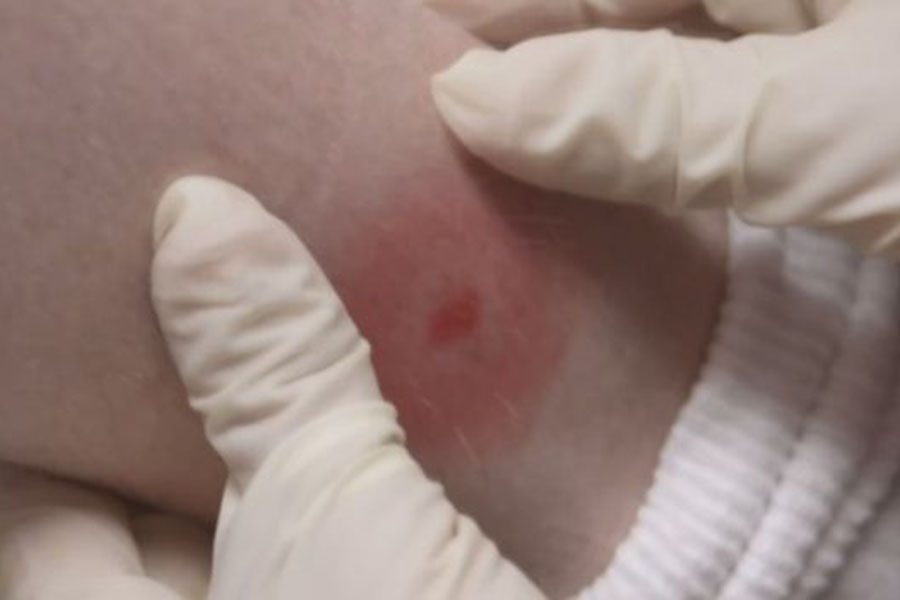The controversy behind Lyme Disease
This is the bullseye rash that is commonly associated with Lyme Disease, since many patients find this shape somewhere on their body. “I didn’t find the tick bite,” Kotelly stated. Not all cases are found with a bullseye, which makes it even harder than it already is to determine if someone has the disease.
June 11, 2019
A common misunderstanding that many people in society hold is that Lyme Disease is transferred by ticks, which in a way is true, but not completely. Lyme Disease is spread through a bacteria called Borrelia Burgdorferi. When a tick bites a person it sucks an individual’s blood until the tick is fully engorged. They then regurgitate the blood back into the human bloodstream. The blood that reenters the bloodstream has the Borrelia Burgdorferi bacteria within it, which causes Lyme Disease.
Lyme splits into two main types; Early Lyme and Chronic Lyme. Some earlier symptoms are the bullseye, rashes, headaches and muscle pain. On the other hand, some chronic symptoms are damage to the way one can function, arthritis like symptoms, and problems with short-term memory. However, each person’s case is different, while they suffer from a variety of different symptoms and experience these symptoms for different amounts of time. According to Amber Fox, one of the school nurses at Hollis Brookline High School, “different people have it manifest in their body in different ways.” The earlier Lyme is detected, the better chance there is of treating the symptoms, where Chronic Lyme is harder to alleviate the pain of the more extreme symptoms.
You may be thinking: how can there be controversy behind this? Believe it or not there are doctors who don’t consider Lyme to be a disease. You read it right, many doctors tell their patients they aren’t suffering from Lyme because it simply isn’t a thing. These doctors don’t believe in the disease for two main reasons; the symptoms are so similar to other diseases’ symptoms that they misdiagnose patients or they say that they are experiencing something psychosomatic. Kelley Ducharme, the second nurse for Hollis Brookine’s High School, explained how “tests are not always accurate and a lot of false negatives come, which brings along misdiagnosis.” Psychosomatic means that their patients are suffering from a mental, internal conflict that is causing the symptoms. Imagine suffering through multiple, uncomfortable symptoms, that in many cases ruin lives, then visiting a doctor in hopes of receiving help, only to be told that you are making the symptoms up and it’s all in your head.
Doctors can treat the symptoms, but there is no cure for Lyme Disease as of now. The fact of the matter is that there is not enough attention towards this disease that is ruining lives. Three hundred thousand people suffer from Lyme annually, and this is just in the United states. Not only are people suffering from the disease itself, but Fox also added that “if someone has had it for a longer time depression can also be seen.” As depression can become an additional weight onto the shoulders of patients this creates more suffering for patients.
It’s very likely that you know someone who has Lyme Disease, and if you don’t, people in our community do. Sophia Kotelly ‘20 was diagnosed with Lyme Disease in eighth grade and still experiences symptoms today. She has been told by doctors that she didn’t have Lyme Disease, however she tested positive on the Western Blot Test. The test examines the blood of the patient, and the results come back in a form that resembles a barcode. If multiple stripes appear (more than one or two) this indicates the presence of the bacteria Borellia Burgdorferi. Kotelly is treated as if she had Fibromyalgia and Chronic Fatigue. She receives her treatment for these two syndromes from Boston Children’s Hospital, but the doctors there don’t take the Lyme Disease into consideration since they don’t believe in such a thing. Kotelly also visits a Homeopathic Doctor for the actual Lyme Disease. Homeopathic Doctors evaluate each patient and determine the best natural remedy depending on their case and symptoms they are experiencing.
“Symptoms don’t always determine a disease, and they can be treated individually even if the disease isn’t diagnosed in the mainstream medical world, but Lyme Disease has many symptoms,” Kotelly explained.
Even Hollis Brookline’s School nurses have treated students for this disease. Whether it is prescribed medication kept in the medical office, or if they have to help students alleviate their pain the nurses have to aid to some students. Ducharme sees many cases of joint pain and fatigue within the students she aides to.
When it comes down to patients; they aren’t receiving the help they deserve. More research and time needs to be dedicated towards this medical mystery.
Interested in learning more?
Please visit http://campingcooks.com/lyme-disease-guide/ for more information.














